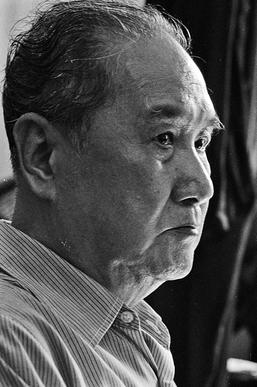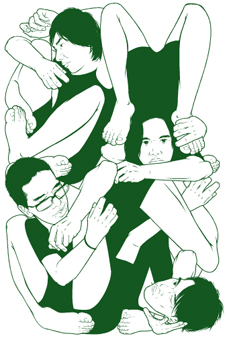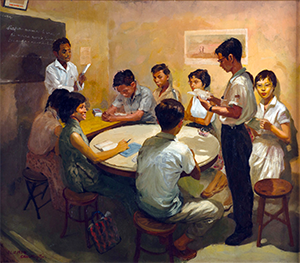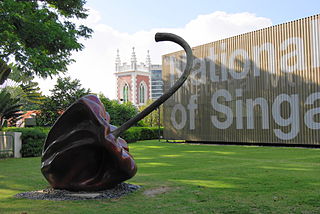Related Research Articles

Chen ( ) is a common Chinese-language surname and one of the most common surnames in Asia. It is the most common surname in Taiwan (2010) and Singapore (2000). Chen is also the most common family name in Guangdong, Zhejiang, Fujian, Macau, and Hong Kong. It is the most common surname in Xiamen, the ancestral hometown of many overseas Hoklo.
LGBT art in Singapore, or queer art in Singapore, broadly refers to modern and contemporary visual art practices that draw on lesbian, gay, bisexual, and transgender+ imagery and themes, addressing topics such as LGBT rights, history and culture in Singapore. Such queer art practices are often by Singaporean or Singapore-based visual artists and curators who identify as LGBT+ or queer.
Lynnette Seah Mei Tsing is a Singaporean violinist serving as co-leader of the Singapore Symphony Orchestra (SSO). She received the Cultural Medallion for Music in 2006.

Liu Kang was a Singaporean artist known for his Balinese-themed figurative paintings. He was a founding member of the Singapore Art Society, and was credited with developing the Nanyang Style, an art style associated with the Nanyang Academy of Fine Arts.

Syed Thajudeen Shaik Abu Talib is a Malaysian painter. He is known for his large scale mural paintings of epic proportions set in period landscapes. A distinctive stylisation, romantic treatment of subject matter and the rich colours as in the Ajanta cave paintings of Maharashtra and of the Mughal are apparent in his works. This, together with the traditional visual arts' integral connection with literature, music, dance, sculpture and philosophy, helped shape Syed's early works. His works, as individualistic as they are, attempt to evoke a state of rasa, or heightened mood that belongs to a larger tapestry and sensibility of Asian artistic traditions. In many instances where his favourite subject matters deal with women and love, they share the same archetypal symbols and metaphors.

Chen Chong Swee was a Singaporean watercolourist belonging to the pioneer generation of artists espousing the Nanyang-styled painting unique to Singapore, at the turn of the 20th century. He was also one of the first artists in Singapore to use Chinese ink painting techniques to render scenery and figurative paintings of local and Southeast Asian themes.

Chen Wen Hsi was a Chinese-born Singaporean artist, known for his avant-garde Chinese paintings.
Ong Kim Seng, was born in Singapore and has been a full-time artist since 1985. He has participated in group and solo exhibitions at Singapore and in the United States, China, United Kingdom, Japan, Australia, Belgium, Federal Republic of Germany, France, Middle East, Taiwan, Hong Kong, and the ASEAN countries.

Georgette Liying Chendana Chen, most commonly known as Georgette Chen, was a Singaporean painter and one of the pioneers of modern Singaporean art as well as the Nanyang style of art in the region.

PHUNK is a Singapore-based contemporary art and design collective founded by Alvin Tan, Melvin Chee, Jackson Tan, and William Chan in 1994. They have exhibited and collaborated with artists, designers and fashion brands around the world, producing work across a diverse range of mediums.

Mohammad Din Mohammad was a Singaporean Malay artist known for his works inspired by Sufism, with his artistic practice spanning painting, assemblage, and Islamic calligraphy. Mhd Din's works are also heavily influenced by his devotion to the practice of the Malay martial arts called silat. He was also a practising bomoh or traditional healer.
Gajah Gallery is an art gallery in Singapore that hosts artwork related to the socio-cultural interests of Asia. It was established in 1995 by Jasdeep Sandhu and promotes Southeast Asian Contemporary Art with an emphasis on Indonesian Contemporary. The gallery holds exhibitions, some of which have been collaborations with the Singapore Art Museum (SAM) and the National University of Singapore Museum (NUS). Gajah Gallery is also a member of Art Galleries Association in Singapore.

Chen Qi is a Chinese artist and co-founder of the Amphibism Art movement in early 1990s. Chen was born in Shenyang, China, in the midst of Great Leap Forward. After 1989, he moved to Singapore, and in 2015 he moved to California. Chen is best known for his figurative oil and ink paintings, which fuse Western and Eastern painting techniques into a whole new genre.

Chua Mia Tee is a Chinese-born Singaporean artist known for his social realist oil paintings capturing the social and political conditions of Singapore and Malaya in the 1950s and 60s. Chua was involved in the Equator Art Society, an artist group founded in 1956 whose social realist works sought to instil a distinct Malayan consciousness by representing the realities and struggles of the masses. For his contributions to the visual arts in Singapore, Chua was awarded the Cultural Medallion in 2015.

Dato' Chuah Thean Teng, also known as Cai Tianding, was a Malaysian artist who is credited with the development of batik as a painting technique.

The visual art of Singapore, or Singaporean art, refers to all forms of visual art in or associated with Singapore throughout its history and towards the present-day. The history of Singaporean art includes the indigenous artistic traditions of the Malay Archipelago and the diverse visual practices of itinerant artists and migrants from China, the Indian subcontinent, and Europe.

The Equator Art Society was an artists' group founded in 1956 in Singapore, known for promoting social realist art. The Equator Art Society sought to represent the realities and struggles of the masses, depicting Singapore's working classes and the poor often through the use of portraiture painting, woodcut prints, and sculpture. Founding society members and leaders included artists such as Lim Yew Kuan, Lai Kui Fang, Chua Mia Tee, Ong Kim Seng and Koeh Sia Yong.

Kumari Nahappan is a Malaysian-born Singaporean contemporary artist best known for her large-scale public sculptures that often depict natural subjects such as fruit, seeds, and spices. Aside from sculpture and public art, Nahappan's interdisciplinary practice also spans installation and abstract painting.

Wong Keen is a Singaporean painter who was primarily trained in New York. He is known for being one of the first Singaporean artists to be educated in the United States and for his syncretic body of work that melds together the sensibilities of Chinese literati painting and the New York School. His practice, unusual for his generation, has led to him being described as "Singapore's first abstract expressionist". From 1969 to 1996, Wong also founded and operated Keen Gallery in New York, a framing studio and exhibition space.
Ang Ah Tee is a Singaporean painter. He received the Cultural Medallion in 2009.
References
- ↑ Correspondent, Chin Soo FangSenior (2022-04-20). "Artist Tan Choh Tee turns to still life painting in the pandemic". The Straits Times. ISSN 0585-3923 . Retrieved 2024-08-26.
{{cite news}}:|last=has generic name (help) - ↑ "Choh Tee gives up stable job for love of art". 4 April 1979.
- ↑ "The Shophouses of Tan Choh Tee 陈楚智". ARTualize. Retrieved 2024-08-26.
- ↑ "Singapore River". www.roots.gov.sg. Retrieved 2024-08-26.
- ↑ "VISUAL ARTIST - TAN CHOH TEE". tfcsea.nafa.edu.sg. Retrieved 2024-08-26.
- 1 2 "artcommune | Tan Choh Tee". artcommune. Retrieved 2024-08-26.
- ↑ "Tan Choh Tee | Artworks for Sale in Singapore". Cape of Good Hope Art Gallery. Retrieved 2024-08-26.
- ↑ "Tan Choh Tee 陈楚智". Gallery NaWei. Retrieved 2024-08-26.
- ↑ "Five iconic Singaporean artists you need to know, from Georgette Chen to Sarkasi Said". 18 December 2017.
- ↑ "Tan Choh Tee". www.nlb.gov.sg. Retrieved 2024-08-26.